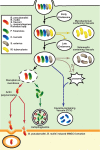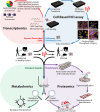Mitigating the Impact of Antibacterial Drug Resistance through Host-Directed Therapies: Current Progress, Outlook, and Challenges
- PMID: 29382729
- PMCID: PMC5790911
- DOI: 10.1128/mBio.01932-17
Mitigating the Impact of Antibacterial Drug Resistance through Host-Directed Therapies: Current Progress, Outlook, and Challenges
Abstract
Increasing incidences of multidrug resistance in pathogenic bacteria threaten our ability to treat and manage bacterial infection. The development and FDA approval of novel antibiotics have slowed over the past decade; therefore, the adoption and improvement of alternative therapeutic strategies are critical for addressing the threat posed by multidrug-resistant bacteria. Host-directed therapies utilize small-molecule drugs and proteins to alter the host response to pathogen infection. Here, we highlight strategies for modulating the host inflammatory response to enhance bacterial clearance, small-molecule potentiation of innate immunity, and targeting of host factors that are exploited by pathogen virulence factors. Application of state-of-the-art "omic" technologies, including proteomics, transcriptomics, and image-omics (image-based high-throughput phenotypic screening), combined with powerful bioinformatics tools will enable the modeling of key signaling pathways in the host-pathogen interplay and aid in the identification of host proteins for therapeutic targeting and the discovery of host-directed small molecules that will regulate bacterial infection. We conclude with an outlook on research needed to overcome the challenges associated with transitioning host-directed therapies into a clinical setting.
Keywords: antibiotic resistance; fluorescent image analysis; inflammation; innate immunity; multidrug resistance; proteomics.
Figures



References
-
- McGann P, Snesrud E, Maybank R, Corey B, Ong AC, Clifford R, Hinkle M, Whitman T, Lesho E, Schaecher KE. 2016. Escherichia coli harboring mcr-1 and blaCTX-M on a novel IncF plasmid: first report of mcr-1 in the United States. Antimicrob Agents Chemother 60:4420–4421. doi:10.1128/AAC.01103-16. - DOI - PMC - PubMed
-
- Magiorakos AP, Srinivasan A, Carey RB, Carmeli Y, Falagas ME, Giske CG, Harbarth S, Hindler JF, Kahlmeter G, Olsson-Liljequist B, Paterson DL, Rice LB, Stelling J, Struelens MJ, Vatopoulos A, Weber JT, Monnet DL. 2012. Multidrug-resistant, extensively drug-resistant and pandrug-resistant bacteria: an international expert proposal for interim standard definitions for acquired resistance. Clin Microbiol Infect 18:268–281. doi:10.1111/j.1469-0691.2011.03570.x. - DOI - PubMed
-
- World Health Organization 2014. Antimicrobial resistance: global report on surveillance 2014. World Health Organization, Geneva, Switzerland.
Publication types
MeSH terms
Substances
LinkOut - more resources
Full Text Sources
Other Literature Sources
Medical
Miscellaneous
